ADAS and Autonomous Driving Tier 1 Research Report, 2023 - Foreign Companies
Research on foreign ADAS Tier 1 suppliers: 4D radar starts volume production, and CMS becomes a new battlefield.
1. Global Tier 1 suppliers boast complete ADAS/AD product matrix, and make continuous efforts to grab the Chinese market.
From the ADAS/AD product matrix, it can be seen that some Tier 1 leaders have almost complete product matrix.
For example, Continental’s latest products include: cockpit monitoring system (CMS, OMS), configured with an OMS camera and a cockpit radar and expected to be released in 2024; HRL131, a 1550nm long-range LiDAR with a detection range of more than 300m, 128° HFOV, 28° VFOV, expected to be mass-produced in 2024; and CUS320, a ultrasonic radar with a detection range of 0.1m-6m, expected to be spawned in 2024.
Bosch has a full range of ADAS/AD products except CMS. Its latest products include: a 1550nm long-range LiDAR, physically displayed at the CES 2023, with a detection range of over 200m and power consumption of less than 20W; an in-cabin monitoring system (IMS, OMS), configured with an OMS camera installed above the center console screen or integrated with the interior rearview mirror, and expected to come into mass production in 2024.
Yet in terms of solutions, currently few global Tier 1 suppliers deploy driving-parking integrated solutions that are hot in China, mainly because it takes them a period of about 2 or 3 years to launch the solutions after they put forward. One example is Continental’s Ambarella CV3-based L2+ solution which was announced in January 2021 but will not be production-ready until 2026.
To cope with the current passive position, global Tier 1 suppliers are also trying to seek changes. For example, Wave3, Bosch’s driving-parking integrated solution, is being developed simultaneously by the XC Division in China and the headquarters in Germany, of which the Chinese solution adopts dual Orin SoCs and is scheduled to be mass-produced in 2023 at the earliest; in June 2023, ZF announced the merger of the divisions for passenger car chassis technology and active safety technology to reduce the internal friction between divisions when making decisions and shorten the time-to-market of products and solutions. In the future, ZF may build a corporate architecture where the active safety integrates all the vehicle businesses such as cockpit and chassis.
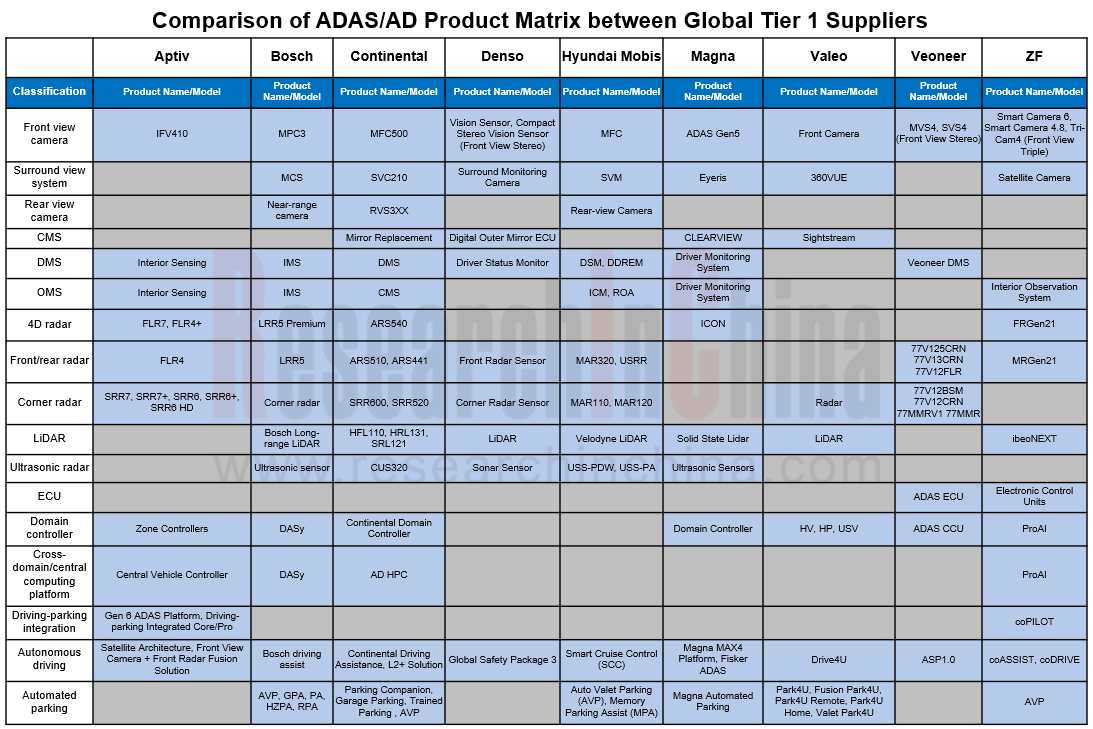
2. 4D radars begin to find mass adoption, and global Tier 1 suppliers grab first-mover advantages.
According to our data, from January to May 2023, the overall installations of 4D radars in new passenger cars in China were 65,500 units, of which 35,700 units were front view and rear view radars, and 29,800 units were corner radars. Models confirmed to pack 4D radars include Rising Auto R7, Li Auto L7 Pro and AITO M5.
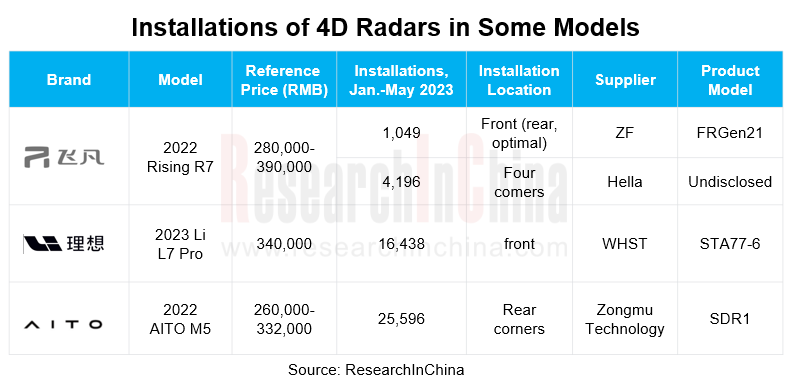
4D radars have passed through three development phases: infancy, growth and SOP.
Infancy: before 2022, foreign Tier 1 suppliers were the first to start upgrading from conventional 3D radar to 4D radar, for example, Continental went about developing ARS540 early in 2016.
Growth: during 2022-2024, Chinese suppliers set about deploying 4D radar products. For example, in 2022 Nova Electronics introduced 4D-S front radar and corner radar products, as well as a new 6-cascade product; Freetech released FVR40 in 2022.
SOP: beyond 2024, it is expected that 4D radars will begin to be spawned and mounted on vehicles.
Currently, 4D radars are still in the verification phase, and whether the installations will rise depends on the following:
(1) Verify the cost performance of 4D radars (replacing ordinary radars) used in low-level driving assistance solutions (L2-L2+). Examples include Aptiv’s satellite architecture-based sensing and computing system that supports L2 and L2+ with 5R5V12U.
(2) Verify the feasibility of 4D radars replacing LiDAR in high-level intelligent driving solutions (L2.5-L2.9, that is, supporting ADAS in highway NOA and city NOA).
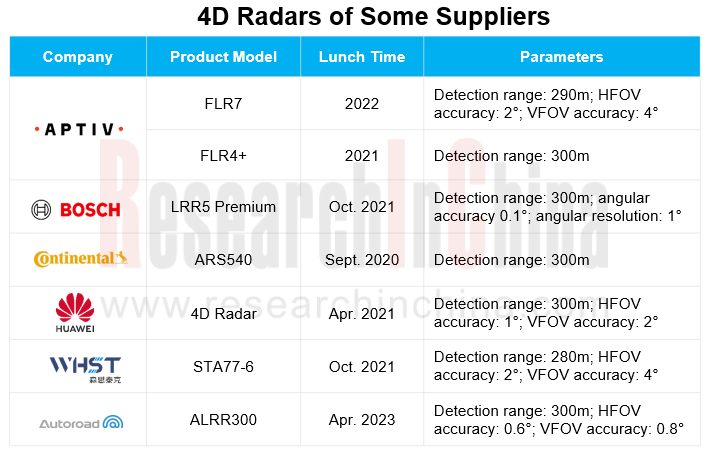
3. China’s adjusted regulation allows CMS to be installed in vehicles, and the competition in the new market is fierce.
On July 1, 2023, the GB 15084-2022 Motor Vehicles - Devices for Indirect Vision - Requirements of Performance and Installation came into effect, specifying that Class M/N motor vehicles are allowed to carry electronic rearview mirrors to replace conventional optical exterior rearview mirrors.
At present, a number of global Tier 1 suppliers, Chinese suppliers and automakers have already made layout of CMS products. Wherein, the global Tier 1 suppliers that have unveiled/mass-produced CMS products include Continental, Magna and Valeo; Chinese suppliers include Autocruis, Voyager Technology, Foryou Group and etc.
On the whole, global Tier 1 suppliers start CMS layout a little earlier than Chinese companies, due to early introduction of regulations.
From a technical point of view, the mainstream CMS solution currently adopted by global Tier 1 suppliers is 2 CMS cameras + 2 OLED displays, that is, replace the left and right rearview mirrors with 2 rearview CMS cameras (generally wide-angle cameras). Another solution of 3 CMS cameras + 2 OLED displays + streaming rearview camera/center console screen is adopted by relatively few companies, as it involves additional technologies such as image stitching/correction. A typical case is Magna CLEARVIEW that adopts the solution of 3 CMS cameras + streaming media rearview mirror tiled display. Noticeably, Magna also proposed a solution of 2 CMS cameras + 2 OLED displays in 2017, but the product Magna actually produces in quantities is still the current 3CMS solution.
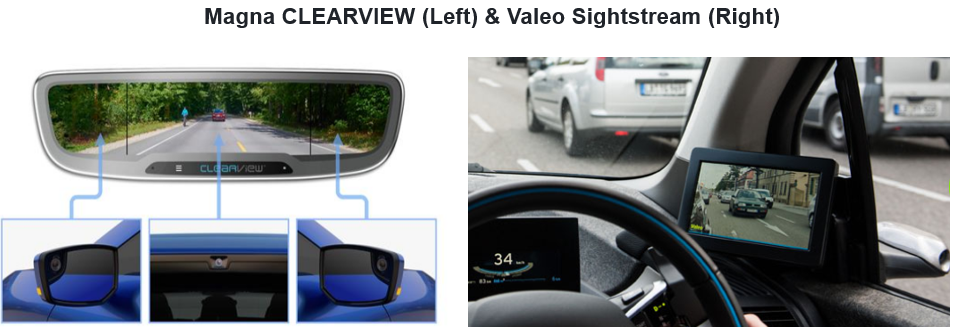
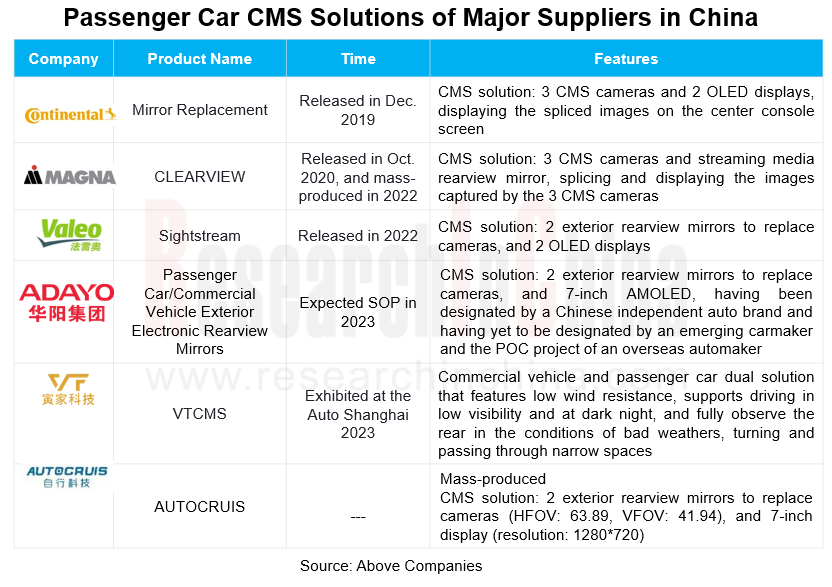
4. As decision products upgrade, a number of Tier 1 suppliers have launched cross-domain/central computing platforms.
As automotive architecture upgrades, the main control units of vehicle internal electronics have also evolved from hundreds of ECUs to several domain controllers. Next cross-domain computing platforms (e.g., cockpit-parking integrated domain controller and driving-parking integrated domain controller) will be used to meet the computing needs of vehicles. In the future, central computing platforms will be used to complete all the computing tasks and enable centralized E/E architecture.
In current stage, several global Tier 1 suppliers have released/iterated multi-domain/central computing platform solutions in 2022. In terms of time node, they are the next-generation alternative to domain controller products.
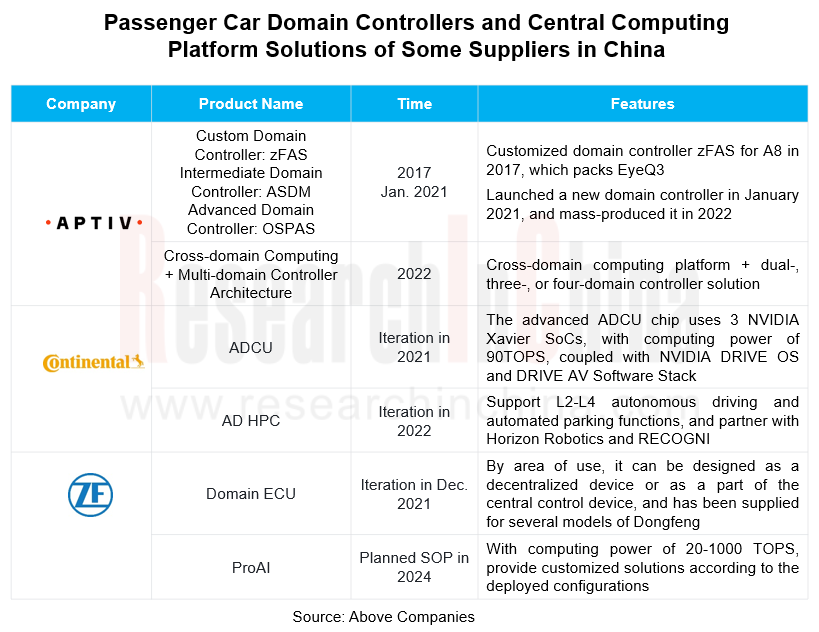
The early solutions include ZF ProAI, which has gone through several iterations, with the computing power increased from 1-10 TOPS to the current 20-1500 TOPS. The latest version of ProAI, scheduled to start volume production in 2024, enables cross-domain computing, packs ZF's domain control middleware, and is optimized for deep learning. Aptiv, on the other hand, puts forward three solutions based on a cross-domain computing platform: a cross-domain computing platform + dual domain controllers, a cross-domain computing platform + three domain controllers, and a cross-domain computing platform + four domain controllers.
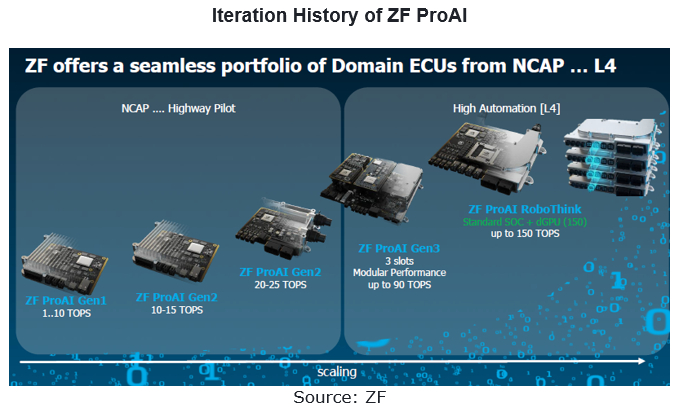
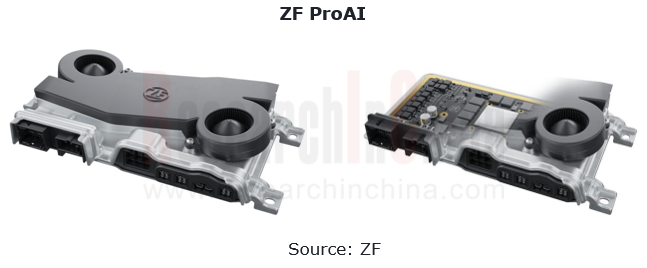
1 Global Regulations on Application of Autonomous Driving on Roads and Development Plans
1.1 Global Regulations on Application of Autonomous Driving on Roads
1.1.1 UN Automated Lane Keeping Systems (ALKS) - Main Test Items
1.1.1 UN Automated Lane Keeping Systems (ALKS) - System Safety and Failsafe Response
1.1.1 UN Automated Lane Keeping Systems (ALKS) - Human Machine Interface (HMI) / Operator information
1.1.1 UN Automated Lane Keeping Systems (ALKS) - Object Event Detection and Data Storage
1.1.2 Summary on Autonomous Driving Development Plans of Some Countries/Regions
1.2 European Union & Europe’s Regulations on Application of Autonomous Driving on Roads
1.2.1 Germany’s Law on Autonomous Driving
1.2.2 EU & Europe’s Autonomous Driving Development Plan
1.2.3 EU Autonomous Driving Roadmap and 2040 Outlook
1.3 United Sates’ Regulations on Application of Autonomous Driving on Roads
1.3.1 US Autonomous Driving Development Plan
1.4 Japan’s Regulations on Application of Autonomous Driving on Roads
1.4.1 Japan's Action Plan for Realizing and Popularizing Autonomous Driving 4.0
1.4.2 Japan’s Autonomous Driving Development Plan
1.4.3 Japan’s "RoAD to the L4 Project" - 4 Major Themes
1.5 South Korea’s Regulations on Application of Autonomous Driving on Roads
1.5.1 South Korea’s Autonomous Driving Development Plan
2 Development Trends of Products and Solutions of Global Tier 1 Suppliers
2.1 SOP of New Products: the Volume Production of 4D Radars Starts
2.2 Regulation Adjustment: China Allows for Use of CMS in Vehicles
2.3 Product Upgrade: from Domain Controller to Central Computing Platform
2.4 Solution Upgrade: from Automated Driving/Parking to Driving-parking Integration
2.5 R&D Direction: Product Matrix Improvement + Product Iteration
3 Key Foreign Autonomous Driving Tier 1 Suppliers
3.1 Aptiv
3.1.1 Profile
3.1.2 Revenue
3.1.3 Competitors/Main Customers
3.1.4 Product Classification
3.1.5 Perception Products - Front View Camera
3.1.6 Perception Products - 4D Front Radar
3.1.7 Perception Products - Corner Radar
3.1.8 Decision Products - Domain Controller/Central Computing Platform
3.1.9 Solutions - Driving-parking Integration
3.1.10 Solutions - Autonomous Driving
3.1.11 Autonomous Driving Layout
3.1.12 Product/Market Planning
3.1.13 Summary
3.2 Bosch
3.2.1 Profile
3.2.2 Revenue
3.2.3 Product Classification
3.2.4 Perception Products - Front View Camera
3.2.5 Perception Products - Surround View System
3.2.6 Perception Products - 4D Front Radar
3.2.7 Perception Products - Front Radar
3.2.8 Perception Products – Corner Radar
3.2.9 Perception Products - LiDAR
3.2.10 Perception Products - DMS/OMS
3.2.11 Perception Products - Ultrasonic Radar
3.2.12 Decision Products - Domain Controller
3.2.13 Middleware
3.2.14 Solutions - Autonomous Driving
3.2.15 Solutions - Automated Parking
3.2.16 Recent Development Layout/Planning
3.2.17 Autonomous Driving Partners
3.2.18 Summary
3.3 Continental
3.3.1 Profile
3.3.2 Revenue
3.3.3 Product Classification
3.3.4 Perception Products - Front View Camera
3.3.5 Perception Products - Rear View Camera
3.3.6 Perception Products - Surround View System
3.3.7 Perception Products – CMS
3.3.8 Perception Products - DMS
3.3.9 Perception Products– OMS
3.3.10 Perception Products - Front Radar
3.3.11 Perception Products - Corner Radar
3.3.12 Perception Products - LiDAR
3.3.13 Perception Products - Ultrasonic Radar
3.3.14 Decision Products - Domain Controller
3.3.15 Decision Products - Central Computing Platform
3.3.16 Solutions - Autonomous Driving
3.3.17 Solutions - Automated Parking
3.3.18 Solutions - Road Data Solution
3.3.19 Engineering Solutions
3.3.20 Robotaxi
3.3.21 Autonomous Driving Roadmap
3.3.22 Continental China's Autonomous Driving Planning
3.3.23 Autonomous Driving Technologies
3.3.24 Summary
3.4 Denso
3.4.1 Profile
3.4.2 Revenue
3.4.3 Product Classification
3.4.4 Perception Products - Front View Camera
3.4.5 Perception Products - Surround View System
3.4.6 Perception Products - Front Radar
3.4.7 Perception Products - LiDAR
3.4.8 Perception Products - Ultrasonic Radar
3.4.9 Solutions - ADAS
3.4.10 Solutions - Autonomous Driving
3.4.11 Autonomous Driving Development Roadmap
3.4.12 Autonomous Driving Capabilities and R&D Layout
3.4.13 Summary
3.5 Hyundai Mobis
3.5.1 Profile
3.5.2 Revenue
3.5.3 Perception Products - Front View Camera
3.5.4 Perception Products - Surround View System
3.5.5 Perception Products - DMS
3.5.6 Perception Products - Radar
3.5.7 Perception Products - LiDAR & Ultrasonic Radar
3.5.8 Solutions - Automated Parking
3.5.9 Solutions - Autonomous Driving
3.5.10 Autonomous Concept Car
3.5.11 Autonomous Driving Development Planning
3.5.12 Summary
3.6 Magna
3.6.1 Profile
3.6.2 Revenue
3.6.3 Product Classification
3.6.4 Perception Products - Front View Camera
3.6.5 Perception Products - Surround View System
3.6.6 Perception Products - CMS
3.6.7 Perception Products - DMS/OMS
3.6.8 Perception Products - 4D Front/Corner Radar
3.6.9 Perception Products - LiDAR & Ultrasonic Radar
3.6.10 Decision Products - Domain Controller
3.6.11 Solutions - Autonomous Driving
3.6.12 Solutions - Automated Parking
3.6.13 Autonomous Driving & Intelligent Connectivity Planning
3.6.14 Summary
3.7 Valeo
3.7.1 Profile
3.7.2 Revenue
3.7.3 Autonomous Driving Product Layout
3.7.4 Automotive Product Layout
3.7.5 Distribution of R&D Bases in China
3.7.6 Autonomous Driving Products - Front View Camera
3.7.7 Autonomous Driving Products - Surround View System
3.7.8 Autonomous Driving Products - CMS
3.7.9 Autonomous Driving Products - Radar
3.7.10 Autonomous Driving Products - LiDAR
3.7.11 Autonomous Driving Products - Domain Controller
3.7.12 Autonomous Driving Products - Ultrasonic Radar
3.7.13 Solutions - Automated Parking
3.7.14 Solutions - Autonomous Driving
3.7.15 Autonomous Delivery Vehicles
3.7.16 Intent Prediction Technology
3.7.17 360-degree Autonomous Emergency Braking System
3.7.18 Autonomous Driving Product Partners
3.7.19 Summary
3.8 Veoneer
3.8.1 Profile
3.8.2 Revenue
3.8.3 Corporate Development Roadmap
3.8.4 Autonomous Driving Product Layout
3.8.5 Summary on Autonomous Driving Products
3.8.6 Perception Products - Camera
3.8.7 Perception Products - DMS
3.8.8 Perception Products - Radar
3.8.9 Perception Products - LiDAR
3.8.10 Decision Products - Domain Controller
3.8.11 Autonomous Driving Products - Positioning System
3.8.12 Autonomous Driving Products - V2X
3.8.13 Solutions - Autonomous Driving
3.8.14 Development History and Planning of Autonomous Driving Solutions
3.8.15 Main Partners
3.8.16 ADAS Technology Releases, 2021
3.8.17 Application of ADAS Products in Vehicles, 2021
3.8.18 Distribution of ADAS Product Customers, 2021
3.8.19 Summary
3.9 ZF
3.9.1 Profile
3.9.2 Recent Changes in Business Division Structure
3.9.3 Revenue
3.9.4 Product Classification
3.9.5 Perception Products - Front View Camera
3.9.6 Perception Products - Surround View System
3.9.7 Perception Products - OMS
3.9.8 Perception Products - 4D Front Radar
3.9.9 Perception Products - Front Radar
3.9.10 Perception Products - LiDAR & Sound Sensor
3.9.11 Decision Products - Vehicle Computing Platform
3.9.12 Decision Products - Domain Controller & Middleware
3.9.13 Solutions - Autonomous Driving & Driving-parking Integration
3.9.14 Solutions - Automated Parking
3.9.15 Development Trends & Layout
3.9.16 Summary
Autonomous Driving Domain Controller and Central Computing Unit (CCU) Industry Report, 2025
Research on Autonomous Driving Domain Controllers: Monthly Penetration Rate Exceeded 30% for the First Time, and 700T+ Ultrahigh-compute Domain Controller Products Are Rapidly Installed in Vehicles
L...
China Automotive Lighting and Ambient Lighting System Research Report, 2025
Automotive Lighting System Research: In 2025H1, Autonomous Driving System (ADS) Marker Lamps Saw an 11-Fold Year-on-Year Growth and the Installation Rate of Automotive LED Lighting Approached 90...
Ecological Domain and Automotive Hardware Expansion Research Report, 2025
ResearchInChina has released the Ecological Domain and Automotive Hardware Expansion Research Report, 2025, which delves into the application of various automotive extended hardware, supplier ecologic...
Automotive Seating Innovation Technology Trend Research Report, 2025
Automotive Seating Research: With Popularization of Comfort Functions, How to Properly "Stack Functions" for Seating?
This report studies the status quo of seating technologies and functions in aspe...
Research Report on Chinese Suppliers’ Overseas Layout of Intelligent Driving, 2025
Research on Overseas Layout of Intelligent Driving: There Are Multiple Challenges in Overseas Layout, and Light-Asset Cooperation with Foreign Suppliers Emerges as the Optimal Solution at Present
20...
High-Voltage Power Supply in New Energy Vehicle (BMS, BDU, Relay, Integrated Battery Box) Research Report, 2025
The high-voltage power supply system is a core component of new energy vehicles. The battery pack serves as the central energy source, with the capacity of power battery affecting the vehicle's range,...
Automotive Radio Frequency System-on-Chip (RF SoC) and Module Research Report, 2025
Automotive RF SoC Research: The Pace of Introducing "Nerve Endings" such as UWB, NTN Satellite Communication, NearLink, and WIFI into Intelligent Vehicles Quickens
RF SoC (Radio Frequency Syst...
Automotive Power Management ICs and Signal Chain Chips Industry Research Report, 2025
Analog chips are used to process continuous analog signals from the natural world, such as light, sound, electricity/magnetism, position/speed/acceleration, and temperature. They are mainly composed o...
Global and China Electronic Rearview Mirror Industry Report, 2025
Based on the installation location, electronic rearview mirrors can be divided into electronic interior rearview mirrors (i.e., streaming media rearview mirrors) and electronic exterior rearview mirro...
Intelligent Cockpit Tier 1 Supplier Research Report, 2025 (Chinese Companies)
Intelligent Cockpit Tier1 Suppliers Research: Emerging AI Cockpit Products Fuel Layout of Full-Scenario Cockpit Ecosystem
This report mainly analyzes the current layout, innovative products, and deve...
Next-generation Central and Zonal Communication Network Topology and Chip Industry Research Report, 2025
The automotive E/E architecture is evolving towards a "central computing + zonal control" architecture, where the central computing platform is responsible for high-computing-power tasks, and zonal co...
Vehicle-road-cloud Integration and C-V2X Industry Research Report, 2025
Vehicle-side C-V2X Application Scenarios: Transition from R16 to R17, Providing a Communication Base for High-level Autonomous Driving, with the C-V2X On-board Explosion Period Approaching
In 2024, t...
Intelligent Cockpit Patent Analysis Report, 2025
Patent Trend: Three Major Directions of Intelligent Cockpits in 2025
This report explores the development trends of cutting-edge intelligent cockpits from the perspective of patents. The research sco...
Smart Car Information Security (Cybersecurity and Data Security) Research Report, 2025
Research on Automotive Information Security: AI Fusion Intelligent Protection and Ecological Collaboration Ensure Cybersecurity and Data Security
At present, what are the security risks faced by inte...
New Energy Vehicle 800-1000V High-Voltage Architecture and Supply Chain Research Report, 2025
Research on 800-1000V Architecture: to be installed in over 7 million vehicles in 2030, marking the arrival of the era of full-domain high voltage and megawatt supercharging.
In 2025, the 800-1000V h...
Foreign Tier 1 ADAS Suppliers Industry Research Report 2025
Research on Overseas Tier 1 ADAS Suppliers: Three Paths for Foreign Enterprises to Transfer to NOA
Foreign Tier 1 ADAS suppliers are obviously lagging behind in the field of NOA.
In 2024, Aptiv (2.6...
VLA Large Model Applications in Automotive and Robotics Research Report, 2025
ResearchInChina releases "VLA Large Model Applications in Automotive and Robotics Research Report, 2025": The report summarizes and analyzes the technical origin, development stages, application cases...
OEMs’ Next-generation In-vehicle Infotainment (IVI) System Trends Report, 2025
ResearchInChina releases the "OEMs’ Next-generation In-vehicle Infotainment (IVI) System Trends Report, 2025", which sorts out iterative development context of mainstream automakers in terms of infota...